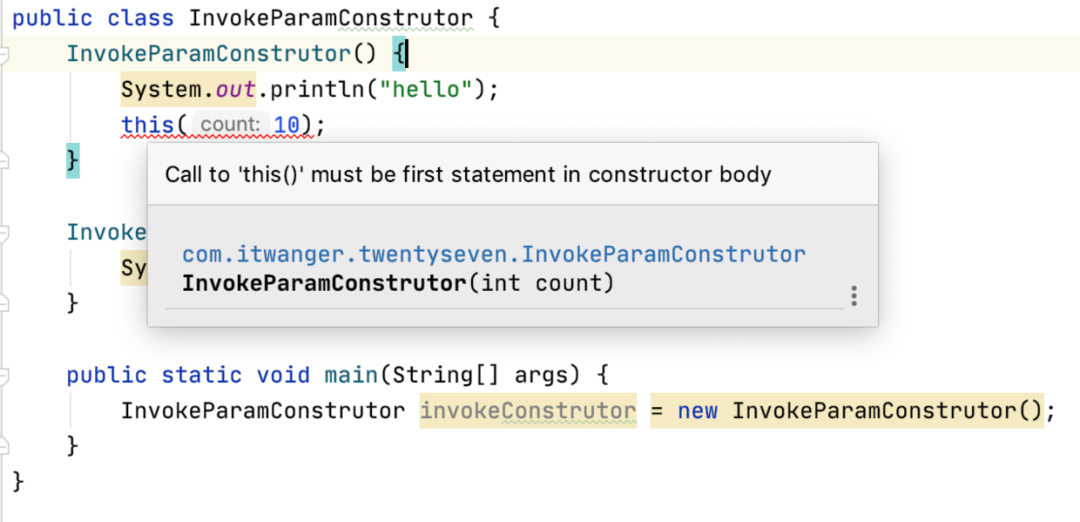“哥,被喊大舅子的感觉怎么样啊?”三妹不怀好意地对我说,她眼睛里充满着不屑。
“说实话,这种感觉还不错。”我有点难为情的回答她,“不过,有一点令我感到些许失落。大家的焦点似乎都是你的颜值,完全忽略了我的盛世美颜啊!”
“哥,你想啥呢,那是因为你文章写得好,不然谁认识我是谁啊!有你这样的哥哥,我还是挺自豪的。”三妹郑重其事地说,“话说今天咱学啥呢?”
“三妹啊,你这句话说得我喜欢。今天来学习一下 Java 中的 this 关键字吧。”喝了一口农夫山泉后,我对三妹说。
“this 关键字有很多种用法,其中最常用的一个是,它可以作为引用变量,指向当前对象。”我面带着朴实无华的微笑继续说,“除此之外, this 关键字还可以完成以下工作。”
- 调用当前类的方法;
- this() 可以调用当前类的构造方法;
- this 可以作为参数在方法中传递;
- this 可以作为参数在构造方法中传递;
- this 可以作为方法的返回值,返回当前类的对象。
01、 指向当前对象
“三妹,来看下面这段代码。”话音刚落,我就在键盘上噼里啪啦一阵敲。
- public class WithoutThisStudent {
- String name;
- int age;
- WithoutThisStudent(String name, int age) {
- name = name;
- age = age;
- }
- void out() {
- System.out.println(name+" " + age);
- }
- public static void main(String[] args) {
- WithoutThisStudent s1 = new WithoutThisStudent("沉默王二", 18);
- WithoutThisStudent s2 = new WithoutThisStudent("沉默王三", 16);
- s1.out();
- s2.out();
- }
- }
“在上面的例子中,构造方法的参数名和实例变量名相同,由于没有使用 this 关键字,所以无法为实例变量赋值。”我抬起右手的食指,指着屏幕上的 name 和 age 对着三妹说。
“来看一下程序的输出结果。”
- null 0
- null 0
“从结果中可以看得出来,尽管创建对象的时候传递了参数,但实例变量并没有赋值。这是因为如果构造方法中没有使用 this 关键字的话,name 和 age 指向的并不是实例变量而是参数本身。”我把脖子扭向右侧,看着三妹说。
“那怎么解决这个问题呢?哥。”三妹着急地问。
“如果参数名和实例变量名产生了冲突.....”我正准备给出答案,三妹打断了我。
“难道用 this 吗?”三妹脱口而出。
“哇,越来越棒了呀,你。”我感觉三妹在学习 Java 这条道路上逐渐有了自己主动思考的意愿。
“是的,来看加上 this 关键字后的代码。”
安静的屋子里又响起了一阵噼里啪啦的键盘声。
- public class WithThisStudent {
- String name;
- int age;
- WithThisStudent(String name, int age) {
- this.name = name;
- this.age = age;
- }
- void out() {
- System.out.println(name+" " + age);
- }
- public static void main(String[] args) {
- WithThisStudent s1 = new WithThisStudent("沉默王二", 18);
- WithThisStudent s2 = new WithThisStudent("沉默王三", 16);
- s1.out();
- s2.out();
- }
- }
“再来看一下程序的输出结果。”
- 沉默王二 18
- 沉默王三 16
“这次,实例变量有值了,在构造方法中,this.xxx 指向的就是实例变量,而不再是参数本身了。”我慢吞吞地说着,“当然了,如果参数名和实例变量名不同的话,就不必使用 this 关键字,但我建议使用 this 关键字,这样的代码更有意义。”
03、调用当前类的方法
“仔细听,三妹,看我敲键盘的速度是不是够快。”
- public class InvokeCurrentClassMethod {
- void method1() {}
- void method2() {
- method1();
- }
- public static void main(String[] args) {
- new InvokeCurrentClassMethod().method1();
- }
- }
“仔细瞧,三妹,上面这段代码中没有见到 this 关键字吧?”我面带着神秘的微笑,准备给三妹变个魔术。
“确实没有,哥,我确认过了。”
“那接下来,神奇的事情就要发生了。”我突然感觉刘谦附身了。
我快速的在 classes 目录下找到 InvokeCurrentClassMethod.class 文件,然后双击打开(IDEA 默认会使用 FernFlower 打开字节码文件)。
- public class InvokeCurrentClassMethod {
- public InvokeCurrentClassMethod() {
- }
- void method1() {
- }
- void method2() {
- this.method1();
- }
- public static void main(String[] args) {
- (new InvokeCurrentClassMethod()).method1();
- }
- }
“瞪大眼睛仔细瞧,三妹,this 关键字是不是出现了?”
“哇,真的呢,好神奇啊!”三妹为了配合我的演出,也是十二分的卖力。
“我们可以在一个类中使用 this 关键字来调用另外一个方法,如果没有使用的话,编译器会自动帮我们加上。”我对自己深厚的编程功底充满自信,“在源代码中,method2() 在调用 method1() 的时候并没有使用 this 关键字,但通过反编译后的字节码可以看得到。”
04、调用当前类的构造方法
“再来看下面这段代码。”
- public class InvokeConstrutor {
- InvokeConstrutor() {
- System.out.println("hello");
- }
- InvokeConstrutor(int count) {
- this();
- System.out.println(count);
- }
- public static void main(String[] args) {
- InvokeConstrutor invokeConstrutor = new InvokeConstrutor(10);
- }
- }
“在有参构造方法 InvokeConstrutor(int count) 中,使用了 this() 来调用无参构造方法 InvokeConstrutor()。”这次,我换成了左手的食指,指着屏幕对三妹说,“this() 可用于调用当前类的构造方法——构造方法可以重用了。”
“来看一下输出结果。”
- hello
- 10
“真的啊,无参构造方法也被调用了,所以程序输出了 hello。”三妹看到输出结果后不假思索地说。
“也可以在无参构造方法中使用 this() 并传递参数来调用有参构造方法。”话音没落,我就在键盘上敲了起来,“来看下面这段代码。”
- public class InvokeParamConstrutor {
- InvokeParamConstrutor() {
- this(10);
- System.out.println("hello");
- }
- InvokeParamConstrutor(int count) {
- System.out.println(count);
- }
- public static void main(String[] args) {
- InvokeParamConstrutor invokeConstrutor = new InvokeParamConstrutor();
- }
- }
“再来看一下程序的输出结果。”
- 10
- hello
“不过,需要注意的是,this() 必须放在构造方法的第一行,否则就报错了。”
05、作为参数在方法中传递
“来看下面这段代码。”
- public class ThisAsParam {
- void method1(ThisAsParam p) {
- System.out.println(p);
- }
- void method2() {
- method1(this);
- }
- public static void main(String[] args) {
- ThisAsParam thisAsParam = new ThisAsParam();
- System.out.println(thisAsParam);
- thisAsParam.method2();
- }
- }
“this 关键字可以作为参数在方法中传递,此时,它指向的是当前类的对象。”一不小心,半个小时过去了,我感到嗓子冒烟,于是赶紧又喝了一口水,润润嗓子后继续说道。
“来看一下输出结果,你就明白了,三妹。”
- com.itwanger.twentyseven.ThisAsParam@77459877
- com.itwanger.twentyseven.ThisAsParam@77459877
“method2() 调用了 method1(),并传递了参数 this,method1() 中打印了当前对象的字符串。main() 方法中打印了 thisAsParam 对象的字符串。从输出结果中可以看得出来,两者是同一个对象。”
06、作为参数在构造方法中传递
“继续来看代码。”
- public class ThisAsConstrutorParam {
- int count = 10;
- ThisAsConstrutorParam() {
- Data data = new Data(this);
- data.out();
- }
- public static void main(String[] args) {
- new ThisAsConstrutorParam();
- }
- }
- class Data {
- ThisAsConstrutorParam param;
- Data(ThisAsConstrutorParam param) {
- this.param = param;
- }
- void out() {
- System.out.println(param.count);
- }
- }
“在构造方法 ThisAsConstrutorParam() 中,我们使用 this 关键字作为参数传递给了 Data 对象,它其实指向的就是 new ThisAsConstrutorParam() 这个对象。”
“this 关键字也可以作为参数在构造方法中传递,它指向的是当前类的对象。当我们需要在多个类中使用一个对象的时候,这非常有用。”
“来看一下输出结果。”
- 10
07、作为方法的返回值
“需要休息会吗?三妹”
“没事的,哥,我的注意力还是很集中的,你继续讲吧。”
“好的,那来继续看代码。”
- public class ThisAsMethodResult {
- ThisAsMethodResult getThisAsMethodResult() {
- return this;
- }
- void out() {
- System.out.println("hello");
- }
- public static void main(String[] args) {
- new ThisAsMethodResult().getThisAsMethodResult().out();
- }
- }
“getThisAsMethodResult() 方法返回了 this 关键字,指向的就是 new ThisAsMethodResult() 这个对象,所以可以紧接着调用 out() 方法——达到了链式调用的目的,这也是 this 关键字非常经典的一种用法。”
“链式调用的形式在 JavaScript 代码更加常见。”为了向三妹证实这一点,我打开了 jQuery 的源码。
“原来这么多链式调用啊!”三妹感叹到。
“是的。”我点点头,然后指着 getThisAsMethodResult() 方法的返回值对三妹说,“需要注意的是,this 关键字作为方法的返回值的时候,方法的返回类型为类的类型。”
“来看一下输出结果。”
- hello
“那么,关于 this 关键字的介绍,就到此为止了。”我活动了一下僵硬的脖子后,对三妹说,“如果你学习劲头还可以的话,我们顺带把 super 关键字捎带着过一下,怎么样?”
“不用了吧,听说 super 关键字更简单,我自己看看就行了,不用你讲了!”
“不不不,三妹啊,你得假装听一下,不然我怎么向读者们交差。”
“噢噢噢噢。”三妹意味深长地笑了。
08、super 关键字
“super 关键字的用法主要有三种。”
- 指向父类对象;
- 调用父类的方法;
- super() 可以调用父类的构造方法。
“其实和 this 有些相似,只不过用意不大相同。”我端起水瓶,咕咚咕咚又喝了几大口,好渴。“每当创建一个子类对象的时候,也会隐式的创建父类对象,由 super 关键字引用。”
“如果父类和子类拥有同样名称的字段,super 关键字可以用来访问父类的同名字段。”
“来看下面这段代码。”
- public class ReferParentField {
- public static void main(String[] args) {
- new Dog().printColor();
- }
- }
- class Animal {
- String color = "白色";
- }
- class Dog extends Animal {
- String color = "黑色";
- void printColor() {
- System.out.println(color);
- System.out.println(super.color);
- }
- }
“父类 Animal 中有一个名为 color 的字段,子类 Dog 中也有一个名为 color 的字段,子类的 printColor() 方法中,通过 super 关键字可以访问父类的 color。”
“来看一下输出结果。”
- 黑色
- 白色
“当子类和父类的方法名相同时,可以使用 super 关键字来调用父类的方法。换句话说,super 关键字可以用于方法重写时访问到父类的方法。”
- public class ReferParentMethod {
- public static void main(String[] args) {
- new Dog().work();
- }
- }
- class Animal {
- void eat() {
- System.out.println("吃...");
- }
- }
- class Dog extends Animal {
- @Override
- void eat() {
- System.out.println("吃...");
- }
- void bark() {
- System.out.println("汪汪汪...");
- }
- void work() {
- super.eat();
- bark();
- }
- }
“瞧,三妹。父类 Animal 和子类 Dog 中都有一个名为 eat() 的方法,通过 super.eat() 可以访问到父类的 eat() 方法。”
等三妹在自我消化的时候,我在键盘上又敲完了一串代码。
- public class ReferParentConstructor {
- public static void main(String[] args) {
- new Dog();
- }
- }
- class Animal {
- Animal(){
- System.out.println("动物来了");
- }
- }
- class Dog extends Animal {
- Dog() {
- super();
- System.out.println("狗狗来了");
- }
- }
“子类 Dog 的构造方法中,第一行代码为 super(),它就是用来调用父类的构造方法的。”
“来看一下输出结果。”
- 动物来了
- 狗狗来了
“当然了,在默认情况下,super() 是可以省略的,编译器会主动去调用父类的构造方法。也就是说,子类即使不使用 super() 主动调用父类的构造方法,父类的构造方法仍然会先执行。”
- public class ReferParentConstructor {
- public static void main(String[] args) {
- new Dog();
- }
- }
- class Animal {
- Animal(){
- System.out.println("动物来了");
- }
- }
- class Dog extends Animal {
- Dog() {
- System.out.println("狗狗来了");
- }
- }
“输出结果和之前一样。”
- 动物来了
- 狗狗来了
“super() 也可以用来调用父类的有参构造方法,这样可以提高代码的可重用性。”
- class Person {
- int id;
- String name;
- Person(int id, String name) {
- this.id = id;
- this.name = name;
- }
- }
- class Emp extends Person {
- float salary;
- Emp(int id, String name, float salary) {
- super(id, name);
- this.salary = salary;
- }
- void display() {
- System.out.println(id + " " + name + " " + salary);
- }
- }
- public class CallParentParamConstrutor {
- public static void main(String[] args) {
- new Emp(1, "沉默王二", 20000f).display();
- }
- }
“Emp 类继承了 Person 类,也就继承了 id 和 name 字段,当在 Emp 中新增了 salary 字段后,构造方法中就可以使用 super(id, name) 来调用父类的有参构造方法。”
“来看一下输出结果。”
- 1 沉默王二 20000.0
三妹点了点头,所有所思。
09、ending
“三妹,this 和 super 关键字我们就学到这里吧,你还有什么问题吗?”三妹学习 Java 的劲头让我对她未来的编程生涯充满了信心。
“没有了,哥,你讲的挺棒的,我已经全部都消化了。”三妹的脸上带着微笑,“对了,哥,《教妹学 Java》已经更新到第 20 讲了,你的 PDF 别忘记同步更新啊!”
“一定一定。”
听我说完,三妹放心地回她自己的小屋休息去了。我趁她不在的这一会时间,把这篇文章编辑到了“沉默王二”公众号,满怀期许地等待留言区的新一波“大舅哥”。
本文转载自微信公众号「沉默王二」,可以通过以下二维码关注。转载本文请联系沉默王二公众号。
































